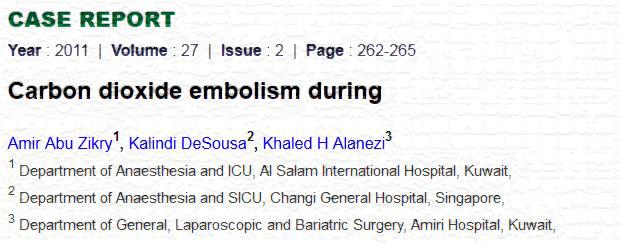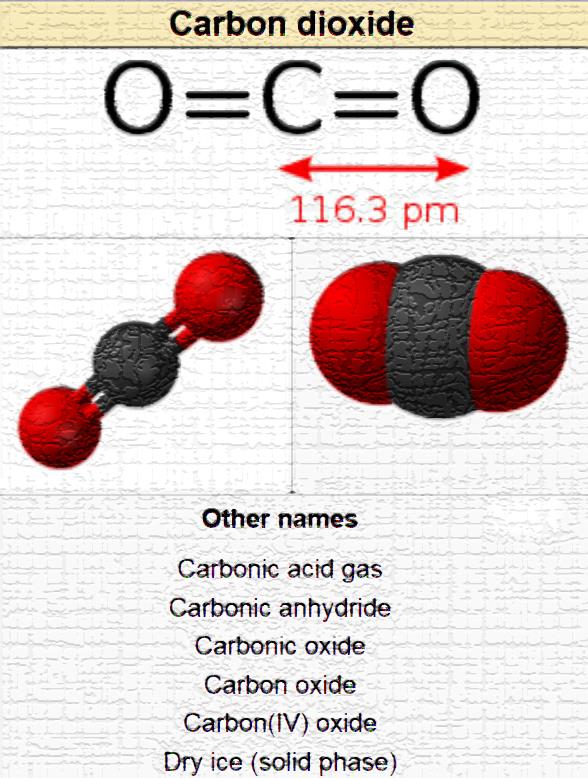CO2 Embolisms & What Not …

Editor’s Note:
We encounter CO2 in the operating room every day. With the advent of so many new OR procedures requiring the use of scopes, mini-incisions, and endoscopic approaches for things like saphenous vein grafting, robotic surgeries, and on and on, the CO2 tank is as necessary and recognizable as an oxygen tank.
There are case reports and literature, that attribute CO2 based embolisms occurring in all of the above mentioned procedures.
Why CO2 ?
CO 2 is cheap, does not support combustion, is non-irritant to the peritoneum, and has a high margin of safety due to its greater solubility (20:1 to oxygen and 25:1 to nitrogen), thus diffusing quickly across the membrane to get excreted rapidly.
Although rare, gas embolism is the most feared and dangerous complication of laparoscopy. Incidence of gas embolism during laparoscopy is reported to be 15 per 100,000 cases per year.
Why this article on CO2 ?
It has been my experience (n=1) to place a patient on bypass when a trocar was inadvertantly introduced to the aorta- and the CO2 insufflator, after 5 minutes, was able to produce an intra-peritoneal pressure high enough to overcome the aortic end diastolic pressure, and therefore introduce CO2 to the coronary arteries and no doubt, some points north.
Immediate code- hence emergent initiation of bypass for hemodynamic support.
Bottom Line ?
Respect the potential that CO2 represents in term of potential embolization to the lungs, heart, or head…
Article of interest:
Although use of carbon dioxide (CO2) blower has been regarded safe during off-pump coronary bypass surgery (OPCAB), we experienced a case of right coronary artery ischaemia induced by retrograde CO2 embolism originating from the opened obtuse marginalis artery during OPCAB. The spray pressure can exceed the diastolic pressure, especially during grafting at the lateral or posterior wall when haemodynamic compromise due to mechanical heart displacement is most severe. In this situation, CO2 blowing at an incompletely slinged coronary arteriotomy site can result in retrograde migration of CO2 into the ascending aorta causing coronary embolism of the right coronary artery.
When signs of ischaemia on the right coronary artery are encountered during grafting of other coronary artery, although CO2 blower has been used, gas embolism should also be considered as the cause and identified at the mid-oesophageal aortic valve long-axis view. When confirmed, the use of gas blower should immediately be discontinued and coronary perfusion pressure increased while allowing time for the CO2 to be absorbed. In case of massive embolism, needle aspiration of the gas should also be considered.
https://www.danaise.com/laparoscopic_surgery_7-5.htm

Click image above to view source article
Points of Interest
The Trocar- and Why CO2 is necessary …
The treatment of a suspected co2 embolism during laparoscopy or any surgical procedure includes the suspension of co2 insufflation with deflation of gas in the abdomen.
It is recommended that the patient should be placed in the left lateral decubitus position and steep Trendelenburg position to allow the gas to rise to the apex of the right ventricle and to prevent entry into the pulmonary artery.
Hyperventilation with 100% oxygen to increase co2 clearance and to relieve hypoxemia and aggressive cardiopulmonary resuscitation should also be performed.
The initial sign of a co2 embolismis the complete loss of an etco2 tracing.
According to Lee et al, “[t]he formation of a co2 embolism during laparoscopy must be suspected whenever there is a sudden change in the end-tidal co2.”
The drop in etco2 is due to a reduction in pulmonary blood flow caused by the embolism. In addition to the drop in etco2, patients also experienced hemodynamic instability.
Typically, it is believed that the hemodynamic compromise is due to a “gas lock” that occurs after high pressure insufflation of co2. This gas lock created by the embolism travels to the vena cava and right atrium, which then decreases venous return and cardiac output.
Geissler et al, give another proposed rationale for cardiac instability. They propose that the primary mechanism for cardiac dysfunction after venous embolism is increased right ventricular afterload and arterial hypotension, possibly with subsequent right ventricular ischemia, rather than right ventricular outflow obstruction by an airlock.
In a review of the current literature, it was found that while venous gas embolism is a rare complication of laparoscopic surgeries, (nearly 0.0014% to 0.6% of laparoscopic cases), it is associated with a 28% mortality rate.


